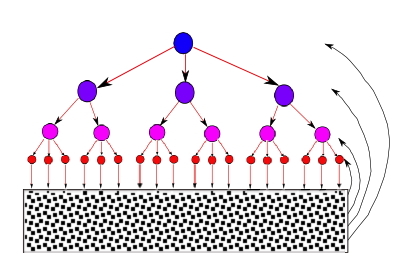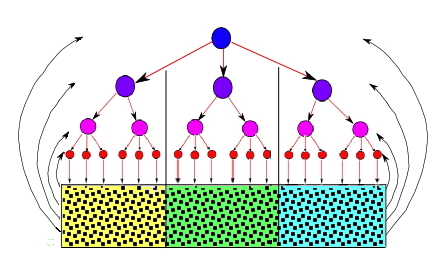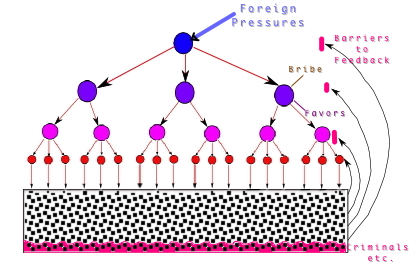Nation Reconciliation and
Reconstruction
Resources for the Concerned Activist
Section 11
State Building

This diagram shows a head of government (president, prime minister,
king, emperor, etc.) at the top. In the next level below there are
three ministries, e.g., war department, state department, tax
department. The number of second-level components is, of course,
arbitrary. Different governments would have different numbers at each
level, depending on their needs. The third level shows an arbitrary
three
sub-ministries for each ministry.
The first model would work as a simplified version of a modern Western
state with some kind of executive at the top. The executive functions
would require more diagramming in the case of the USA because what can
be and is demanded of the people by the government depends on the
president, the congress, and the judiciary. Below them would be a
number of ministries or departments, e.g., defense, revenue, treasury,
etc. The third level would then contain sub-ministries or
sub-departments, e.g., army, navy, air force, etc. under defense.
Probably a full diagram would involve a few more levels than are shown
here, but the object of the whole complex is to regulate and/or serve,
in
certain
respects, the people represented in the rectangle at the bottom.
For the early Prussian state, an example of early success in getting
good channels of control, direction, etc. between the leader and the
people, a well-defined and well-qualified set of agents of the crown
was instrumental in making them a powerful force in Europe. There were
no formal channels of feedback from the people that could effect
changes in the behavior of the government. In the early U.S., there
were government departments that were supposed to take their
instructions from their hierarchical superiors. However, at that point
in history the officials were chosen as a matter of patronage and what
was planned at the top of the hierarchy did not always get reliably
passed on down the line. The people, in contrast to the situation in
Prussia, participated in regular elections for national, state, county,
and municipal government officials.
Without directions passing down the hierarchy reliably, being
implemented in creative and responsible ways, and then information
about the results of each official's efforts being passed accurately
and completely back up the chain of command, governance may not be
adequate
despite any good intentions of officials up and down the hierarchy.
Without the kind of effective feedback provided by voters writing to
their officials and voting against them in the next election if their
efforts were not appreciated, the results of a government can very
easily be aimed solely at gratifying the ambitions of government
officials.
The emperors of China were sometimes forced to deal with difficulties
in top-down
management because they were not having good success in getting their
plans executed. When an emperor issued a directive it would be
transmitted to his minister or ministers with related responsibilities.
Ministry staff would draft instructions for the implementation of the
emperor's directive. Those directions would then be transmitted to
provincial officials, who would make further elaborations in ways of
implementation that would be suited to local conditions. At the end of
the line the instructions would be provided to local members of the
landed gentry who would give orders to the subjects of the crown in
their domain. At the appropriate time the gentry would report the
results of the new project to the lowest level of emperor-appointed
officials, those officials would aggregate their reports and pass a
summary up the chain of command. At each level there could be a process
of aggregation and interpretation of records of results. At each state
of the process there were opportunities for misinterpreting and also
for mis-reporting. So the emperors found that they could not place full
trust in reports of how well their directions had been carried out.
The Chinese emperors invented the office of the Censorate.
Its function
was to send independent observers out to investigate the conduct of the
emperor's business at any and all levels. They virtually spoke with the
authority of the emperor whenever it became clear that the emperor's
will was not being carried out. Naturally, they would report their
findings directly to the emperor's immediate staff. In modern
democracies, a similar function is performed by the free press.
Publication of a scandal in a newspaper of good repute is in itself a
strong impetus to change. Moreover, once behavior that goes against
government regulations or breaks laws is reported in the press,
government officials will generally take note of the problem and take
legal steps to correct matters.
Exactly how governance is carried out turns out, according to the
researches of Francis Fukuyama and his group at Stanford, not
to be particularly important. One state might have a highly articulated
hierarchical structure, and another state might be rather spare in its
architecture. The important thing turns out to be whether the system
and the people in it actually deliver good performance. Planning means
nothing without good execution of those plans.
The model diagrammed above would work as a simplified version of a
modern Western
state with some kind of executive at the top. The executive functions
would require more diagramming in the case of the USA because what can
be and is demanded of the people by the government depends on the
president, the congress, and the judiciary. Below them would be a
number of ministries or departments, e.g., defense, revenue, treasury,
etc. The third level would then contain sub-ministries or
sub-departments, e.g., army, navy, air force, etc. under defense.
Probably a full diagram would involve a few more levels than are shown
here, but the object of the whole thing is to regulate in certain
respects the people represented in the rectangle at the bottom.
For the early Prussian state, an example of early success in getting
good channels of control, direction, etc. between the leader and the
people, a well-defined and well-qualified set of agents of the crown
was instrumental in making them a powerful force in Europe. There were
no formal channels of feedback from the people that could effect
changes in the behavior of the government. In the early U.S., there
were government departments that were supposed to take their
instructions from their hierarchical superiors. However, at that point
in history the officials were chosen as a matter of patronage and what
was planned at the top of the hierarchy did not always get reliably
passed on down the line. The people, in contrast to the situation in
Prussia, participated in regular elections for national, state, county,
and municipal government officials.
Without directions passing down the hierarchy reliably, being
implemented in creative and responsible ways, and then information
about the results of each official's efforts being passed accurately
and completely back up the chain of command, governance may not be good
despite any good intentions of officials up and down the hierarchy.
Without the kind of effective feedback provided by voters writing to
their officials and voting against them in the next election if their
efforts were not appreciated, the results of a government can very
easily be aimed at satisfying the ambitions of government officials.
Historically, the two essentials, responsiveness of the government to
the people and adequate feedback mechanisms such as the vote that
permit the reactions of the citizens of a country to its government to
guide how that government is conducted in the future, do not ordinarily
come into existence at the same time.
Besides the governance and responsiveness necessities, the issue of
allegiance is very important. To thrive, a nation must provide for its
citizens identifying with their country, for seeing that the nation
performs a good service to all of its citizens and it needs also to be
a positive
force with regard to the rest of the world. If citizens were to be
uninvolved with the spirit of their nation they might well consider
only their own interests, shirk their duties to the commonwealth, avoid
taxes and other forms of national service, and probably harbor ill will
because of those things required of them, forgetting that they
benefited in many ways from the willing contributions of others.
Those who hold leadership positions in a modern state need to be able
to articulate the "mission statement" of their country. They need to
attract and legitimatize loyalty to the nation. They need to be in the
position to exhort special efforts from the people in times of need.
They need to be able to explain different possible courses of action to
people and to make compelling arguments for whatever is the best plan
or policy.
To be a well-functioning state it is not necessary that any particular
"architecture" of the state be chosen. The presidential form of
leadership has advantages and disadvantages. So does the
parliamentarian form of government. Even the vote would not be
essential if some other form of feedback would supply equally good and
compelling direction to the organs of government. But obvious defects
will reveal themselves in cases where governance is not efficient, and,
more importantly, when feedback mechanisms fail to work.
A government that is regulated by feedback from the real world will
adapt to changes over time. Providing only that the citizenry is
dedicated to performing its function, a close approximation to the best
possible policies should evolve over time.
A government that is not regulated by the votes of the people will be
only as good as the most responsible, dedicated, and devoted of the
unelected officials can make it. When feedback does not come from
outside, then evaluations strongly tend toward being subjective and
problematical. The result will be failure due to ill-considered
policies, graft and corruption, etc. The higher the office in which
problematical factors derail good procedures and wise judgments, the
greater the peril to the nation.

The highest executive had best not be a member of the yellow group, the green group, or the blue group.
The second diagram is also very much more simple than a real government
would likely become. This diagram is intended to suggest an alternative
to the simple hierarchical form that is often suggested to improve
governance in fragile, failing, or failed states. It may be that there
already exist systems of control that are functional but do not fit
into the stereotypical form diagrammed in the first diagram. Perhaps
there might be no single leader at the top of the governing structure
of some group, and instead three or more leaders would be authorized by
their community to reach decisions only by mutual consent. Perhaps a
group might have two or more leaders, one authorized by the community
to make decisions in times of war, another authorized to make decisions
regarding ordinary civil and community affairs, a third authorized to
communicate to the gods when ordinary human knowledge and lore provided
no answers, and so forth. I haven't tried to diagram such a government
since I lack knowledge of a well-researched nation to base myself on.
The diagram above is intended to suggest a possible model for cases in
which one nation lives within the physical boundaries of another
nation, or cases in which the members of one nation are interspersed
among the members of one or more nations. For instance, there are
several Native American nations that live within the national
boundaries of the United States but retain their own institutions of
government. The federal government of the United States has to do its
best to respect the sovereignty of the Native American nations while
also mediating between their citizens and the citizens who belong to
the numerically far greater general U.S. population.
In the diagram I have suggested a state composed of three large
communities, both of approximately equal population, and a third group
that, for the sake of simplicity and convenience, may be treated
graphically as a single third community. Each of these groups
would have different governing hierarchies, and those hierarchies or
structural forms might be entirely different. However, for them to
function together within the boundaries of a single nation, there would
need to be a capstone governing function headed by one individual or
perhaps by a troika of individuals. All of them would have to be
responsible for acting only on behalf of the general good, and not for
the benefit of members of their own community. There would be a practical
difficulty if a single individual at the pinnacle tried to direct and
coordinate the three subordinate governing councils.
When such a state of three nations had things to do that necessity
required them to work together, then those tasks could not easily or
efficiently be done without a coordinating authority at the top. If a
country of three nations shared a great river and a vast river basin
composed of that river and all of its tributaries, then flood control,
irrigation, navigation, etc. would require the coordination of work
done on that river system. If, for instance, there was a common
plan that shared water rights for irrigation among all people living in
that region, it would not matter if the details of implementation of
the plan were communicated to citizens through three different systems
of control and feedback. But if the ultimate executive authority
resided in the hands of one man or woman who was also a member of one
of those three communities, then he or she might easily be suspected of
favoring his or her own group.
Dag Hammarskjold tried to make the office of Secretary General of the
United Nations function in this way, and, as a citizen of a small
nation, he could more easily claim independence of judgment than could
a Secretary General from some major nation. However, the USSR bitterly
opposed his attempt to create an executive to which they would in any
way become subordinated. He died under mysterious circumstances.

The third diagram adds a few sample interfering factors. Naturally,
there are all sorts of distorting factors that can appear at any
level. Foreign powers may influence the executive level decisions by
grants, by threats, by bribes, and by yet other means. Heads of
ministries or departments may be subject to bribes, physical coercion,
campaign fund offers, etc. etc., for the sake of which they may do
various kinds of favors or make various kinds of deals. The feedback
provided by voters can be influenced by propaganda, vote buying, vote
stealing, ballot box stuffing, etc., etc. In some cases the military of
a country may seize control but use the existing officials to carry out
their will, falsify election results, and so forth. The exterior form
of
a government may persist even though the mechanisms that originally
made it a productive form of human organization have disappeared. When
police states and other forms of totalitarian government are used, the
people may appear to remain loyal and to cohere into a well-functioning
whole. Nevertheless, trust among people is difficult to establish and
maintain under those circumstances, tensions and apprehensions eat away
at individuals, and the real coherence of a normal state become
seriously fragmented.
Analysis
State-Building,
the Unwanted Pregnancy
This page has received
visits.
'
This page was last revised 16 August 2016.


